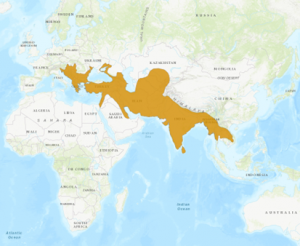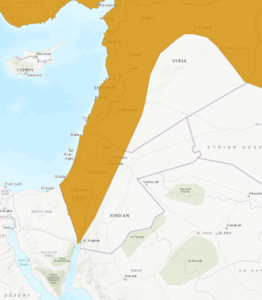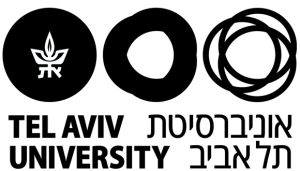Golden Jackal, תן, Canis aureus
Back to FaunaImage gallery
Biblical data
Introduction
The תן can be found fourteen times in the Hebrew Bible.[1] In all these occurrences, the תן appears in a plural form (תנם, תנת.) The תן largely appears within prophetic texts in contexts of divine statements of judgement (twelve times) and, within these occurrences, eight refer to the animal’s habitation (מקום, נוה, מעון). Often, the תן is also employed as part of a metaphor or simile.
Furthermore, the תן often appears paralleled with other animals of the wilderness. The most common parallel is with the בנות יענה (ostriches or owls?) which occurs alongside תן five times. In Isa 13:21–22, the תן also parallels ציים (beasts?), אחים (owls?), שעירים (goat or demon?), איים (hyenas?).
As indicated within the History of Identification discussion, the attempted identification of the תן has been somewhat complex. Generally, the תן has been assumed to refer to the golden jackal (Canis aureus), suggested by its description as living in the wilderness, dwelling in ruins, and its vocal cry. An alternate suggestion is to identify the תן as a subspecies of the Eurasian eagle-owl, (either Bubo bubo desertum or Bubo bubo interpositus; see: Aharoni, 1938, 469–470; and Feliks, 1981, 101–102), however this seems particularly unlikely due to specific mammalian behaviour demonstrated in Lam (4:3, qere). The golden jackal is therefore perhaps the most likely candidate, despite its possible identification with the שׁועל too.
Distribution within the Bible
Eleven of the fourteen references to תן appear in prophetic texts. Four of these are in the book of Isaiah where they appear in prophetic judgements against other nations (Isa 13:22, 34:13), as well as descriptions of future blessings (Isa 35:7, and 43:20).[2] There are five appearances in the book of Jeremiah in which they are found in descriptions of desolation in either the present (Jer 14:6) or future (Jer 9:10, 10:22, 49:33, and 51:37). In Micah (1:8) תן is associated with mourning after a judgement upon Samaria and Jerusalem (Mic 1:8). The only occurrence of the feminine plural form תנות is in Malachi (1:3) which also describes desolation of the country.
Additionally, תן occurs twice in poetry (Ps 44:20; Lam 4:3, qere) and once in wisdom literature (Job 30:29).
Parts, Elements, Features that Are Specified in the Bible
Habitat. The תן is often associated with its habitat and is described as dwelling within desolate areas (Isa 43:20), or regions uninhabited by humans (Isa 13:22). In Malachi (1:3) the תן is explicitly said to live in the “wilderness” or “desert” (מדבר). Furthermore, the close link between תן and this wilderness environment is apparent due to the fact that desolate regions are often called either “the place” (מקום; Ps 44:20), “abode” (נוה; Isa 34:13, 35:7), or “lair” (מעון; Jer 9:10, 10:22, 49:33, 51:37) of jackals. Their habitat also seems to be characterised by the lack of available water (Isa 35:7), and the prevalence of prickly or thorny plants (Isa 34:13).
Vocal cry. The most common behaviour connected with the תן is its vocalisation. They are described as howling (Isa 13:22) and wailing (Mic 1:8) within the wilderness. Job also describes himself as a brother to jackals (Job 30:29), seemingly on account of his activity in crying out for help (Job 30:28). It is also possible that the honour given by the תנים in Isa 43:20 should be understood as a vocalisation (Atkins 2020, 508).
Panting. The תן is also associated with the act of panting, which they seem to do when they are lacking food and water (Jer 14:6). The context, and the fact that their habitat is typified by a general lack of water (Isa 35:7), suggests this might be the principal cause of such behaviour.
Maternal behaviour. Lam 4:3 (qere) indicates the maternal role of the תן in raising young by nursing them with their mother’s milk. Interestingly, while there is an attested feminine plural form of תן (תנות; Mal 1:3), Lam 4:3 uses the masculine plural form (תנים) when describing this maternal behaviour.
Function in Context
All the occurrences of תן have a symbolic function. The lair of תן is used as a metaphor for various settlements that God will destroy, including: Edom (Isa 34:13, Mal 1:3), Jerusalem (Jer 9:10), various cities of Judah (Jer 10:22), Hazor (Jer 49:33), Babylon (Isa 13:22; Jer 51:37), or the land of the Psalmist (Ps 44:20). Their place of abode is also used as a symbol for arid land (Isa 35:7), and their gratefulness to God for water also signifies the usual dry condition of their environment (Isa 43:20). The vocal cries of the תן are used as both a metaphor (Job 30:29) and a simile (Mic 1:8) for human lamentation during a period of grief, and their behaviour of panting for air is used as a simile for how wild asses behave in a period of drought (Jer 14:6). They are also used as a symbol of appropriate care for others (Lam 4:3).
Pairs and Constructions
The תן is paralleled with the בנות יענה as part of a parallelism four times (Isa 34:13; Mic 1:8; Job 30:29; Lam 4:3), and specifically juxtaposed in Isa 43:20. There are multiple different constructions involving the תן:
- כתנים occurs three times: Jer 14:6; Ezek 32:2; Mic 1:8
- לתנים occurs one time: Job 30:29
- במקום תנים occurs one time: Ps 44:20
- נוה תנים occurs one time: Isa 34:13
- בנוה תנים occurs one time: Isa 35:7
- מעון תנים occurs two times: Jer 9:10, 10:22
- מעון־תנים occurs one time: Jer 51:37
- למעון תנים occurs one time: Jer 49:33
- לתנות מדבר occurs one time: Mal 1:3
End Notes
[1] Two further mentions of תן can be found in Ezekiel (29:3, 32:2) where this creature appears to live in water. However, these are likely corrupted forms of תנין and should not be considered to refer to the same animal.
[2] It has been suggested that some of the other creatures mentioned in Isa 13:21–22 (ציים, אחים, and איים) could also refer to a jackal (Day 1915, 1548).
Bibliography
Aharoni, Israel. 1938. “On Some Animals Mentioned in the Bible.” Osiris 5: 461–478.
Atkins, Peter J. 2020. “Praise by Animals in the Hebrew Bible.” Journal for the Study of the Old Testament 44(4): 500–513.
Day, Alfred E. 1915. “Jackal.” Page 1548 in vol. 3 of International Standard Bible Encyclopedia. Edited by James Orr et al. 4 vols. Grand Rapids: W. B. Eerdmans Pub. Co.
Feliks, Yehuda. 1981. Nature and Man in the Bible: Chapters in Biblical Ecology. London: Soncino Press
Contributor: Dr. Peter Joshua Atkins, Biblical Studies, University of edinburgh, Scotland
History of Identification
Identification History Table
Life & Natural Sciences
English: Golden Jackal
Hebrew: תן (Tan)
Scientific Name: Canis aureus (Linnaeus 1758)
ID
Canis aureus
Class – Mammalia
Order – Carnivora
Family – Canidae
Genus – Canis
Species – Canis aureus (Linnaeus 1758)
The Canis aureus is a medium-sized canid. This species is considered as the typical representative of its genus – Canid. In Israel there are two members of this genus – the jackal and the wolf. The golden jackal has relatively short tail and ears. The legs are long comparing to his body. The far color is basically brownish-grey but varies seasonally and among individuals. The tail tip is black. The male is a bit larger than the female. In Israel the jackal’s body mass ranges from 7.5-10 kg in males and 6.5-8 kg in females (e.g. Mendelssohn & Yom-Tov 1999; Moehlman & Hayssen 2018; Yom-Tov & Bar-Oz 2022).

Figure 1: Global distribution map of the golden jackal (Canis aureus) from the IUCN assessment (Hoffmann et al. 2018).

Figure 2: Distribution map of the golden jackal (Canis aureus) in Israel and the surrounding area. Zoom in from the global IUCN assessment (Hoffmann et al. 2018).
Life History
Gestation last 60-63 days. The litter size is 3-8 pups. The young are born in the spring. Newborn open their eyes when 10-14 days old. Longevity in captive is maximum 16 years (Mendelssohn & Yom-Tov 1999).
Characteristics that Appear in the Bible
Distribution and Habitats. The golden jackal is widespread in North and East Africa, Europe, the Middle East, Central and Southeast Asia (Moehlman & Hayssen 2018). Historically, the distribution of this species in Europe was restricted to the coastal regions along the Mediterranean and Black Sea (Krofel et al. 2017). However, in the last two centuries, and more so over the late 20th century, the golden jackal has expanded its range northwards and westwards in many parts of Europe (Moehlman & Hayssen 2018). This expansion is probably due to substantial decline in the population of the grey wolf, which gave the opportunity to the jackal to enter to areas that in the past were controlled by the wolf (Krofel et al. 2017; Giannatos 2004), and is probably connected with the increase of man made food resources.
This species can live in a wide variety of habitats, ranging from semi-arid environments to forested, mangrove, agricultural, rural and semi-urban habitats (Clutton-Brock et al. 1976; Prater 1980; Poche et al. 1987). High densities observed in areas with abundant food and cover. Jackals tolerate of different habitats, including those altered by humans, like villages (Clutton-Brock et al. 1976; Prater 1980; Poche et al. 1987). In the Judea Plain, there is a high concentration of Jackals, who significantly prefer cultivated areas and wetlands combined with caves and with adequate cover for hiding and breeding (Moyal, unpubl.). A study conducted by Mohammadi et al. (2017) observed a wolf kill a golden jackal in an agricultural area. In Israel, the distribution of this species was originally restricted mainly to the Mediterranean region. However, in the last decades Jackals expand their distribution to many parts of the desert and Arava valley and they even reach Eilat. Since the jackal is not a desert species, in this area it mainly exists in places near human settlements, oasis and agriculture areas (Mendelssohn & Yom-Tov 1999; Yom-Tov & Bar-Oz 2022). Range and omnivorous opportunistic diet mean that jackals can live in a wide variety of habitats.
Sociality. Golden jackals are monogamous – the basic social unit is a mated pair and their young (Nowak & Walker 1999; Mendelssohn & Yom-Tov 1999). In places of rich food resources, they gather in big territorial groups of families (Moyal, unpubl.). The group usually contains the parents and some young that stay with them and assist in feeding the new pups. Usually, these young avoid breeding. However, sometimes they mate and raise their own offspring (Nowak & Walker 1999). Probably because of their family structure, there are often reports of large group of jackals hunting and communicating together, but this only occurs when there is a high density of golden jackal in an area (Markov 2012).
Vocalization. The jackal has a variety of vocal expressions. One of the most familiar voices during the nights in Israel (and other areas where the jackal occurs) is of the choruses of jackals. One jackal begins calling, and other from its family and even other families join him. The typical call usually included three different voices – cries, howls and trills (Mendelssohn & Yom-Tov 1999). The jackal uses these voices in defending its territory, maintaining the group cohesion, and finding a mate (Comazzi et al., 2016). Additionally, the jackal barks when other jackals attack him, during fights he also groans, and hums while mating (Mendelssohn & Yom-Tov 1999).
Jackal vs. fox. The jackal and the fox both belong to the canid family. They differ significantly in their appearance (physiology), although, during the night it may be difficult to distinguish between them. The fox is smaller with body mass of 3 kg on average (in Israel), while the jackal weights around 8 kg. The fox’s tail is very long (with conspicuous white tip) and reaches the ground while the jackal’s tail reaches only half of the jackal’s leg height.
They are both carnivores and omnivores (rely on human garbage) that are mainly active during the night. Both species are social animals that live in a family unit. However, while the fox’s family unit usually includes the parents and their young of the current year, the jackal family unit usually comprises the parents, their young of the current year, and even some cubs of the previous year that stay to help raise the new cubs. Therefore, the jackal’s family unit may be much larger than that of the fox. Furthermore, Jackals can group in large flock consisting of several families together (Pecorella et al. 2023), while Fox live in single pair formations with offspring dispersing in the year of birth or form larger philopatric family groups. The latter is only observed occasionally and seems to be linked to different factors such as resource availability (Baker et al. 1998). In the Judea Plain Jackals use ancient caves for breeding and foxes clearly prefer burrows (מאורות) and underground ancient ruins (Moyal, unpubl.).
Unlike the jackal that is famous in its continuous strong howls, the fox does not howl, but classified as a moderately vocalizing predator and divided to different categories as whining, lowing, clucking, growling and mainly barking (Andreychev 2023).
Other Characteristics
Activity period. Mainly active during the night but also during the twilight (Mendelssohn & Yom-Tov1999). In high concentration areas of Jackals, such as in the Judea Plain, they are observed also in the early morning (Moyal, orally).
Diet. Omnivore and opportunistic. Jackal’s diet includes small to medium size mammals, reptiles, amphibians, fish, invertebrates, carrions, plant materials and also human garbage (Mendelssohn & Yom-Tov 1999; Borkowski et al. 2011). A study on Jackals’ diet over a whole year, conducted by Radovic & Kovačić (2010), shows a more varied diet. Meat was still the primary food source, but was supplemented by fruits, seeds and vegetables, which made up a third of their diet. About 1.5%-1.9% of the calves born in the Golan Heights die due to predation, mainly by golden jackals Canis aureus, and the total damage during 1993 was estimated at about 42,000 USD. Most attacks occur within two days after delivery, and male calves are more likely to be attacked than females, probably because they are heavier and more difficult to deliver (Yom-Tov et al. 1995).
End Notes
Andreychev, A. 2023. “Vocalizations by red fox (Vulpes vulpes) in natural and climatic conditions of Mordovia (Middle Volga region). E3S Web of Conferences 462:1004. https://www.e3s-conferences.org/articles/e3sconf/abs/2023/99/e3sconf_afe23_01004/e3sconf_afe23_01004.html.
Baker, P.J, C.P. J. Robertson, , S.M Funk, & S. Harris. 1998. “Potential fitness benefits of group living in the red fox, Vulpes vulpes.” Animal Behaviour 56(6):1411–1424.
Borkowski, J., A. Zalewski & R. Manor. 2011, January. “Diet composition of golden jackals in Israel.” Annales Zoologici Fennici 48(2) 108–118.
Comazzi, C., S. Mattiello, O. Friard, S. Filacorda & M. Gamba. 2016. “Acoustic monitoring of golden jackals in Europe: setting the frame for future analyses.” Bioacoustics 25: 267–278.
Giannatos, G. 2004. Conservation action plan for the golden jackal (Canis aureus L.) in Greece. Greece: WWF Greece.
Hoffmann, M., J. Arnold, J.W. Duckworth, Y. Jhala, J.F. Kamler & M. Krofel. 2018 (errata version published in 2020). “Canis aureus.” The IUCN Red List of Threatened Species 2018: e.T118264161A163507876. https://dx.doi.org/10.2305/IUCN.UK.2018-2.RLTS.T118264161A163507876.en
Krofel, M., G. Giannatos, D. Ćirovič, S. Stoyanov & T.M. Newsome. 2017. “Golden Jackal Expansion in Europe: A Case of Mesopredator Release Triggered by Continent-wide Wolf Persecution?” Hystrix: Italian Journal of Mammalogy 28: 9–15.
Markov, G. 2012. “Golden Jackal (Canis aureus L.) in Bulgaria: What is Going on?” Acta Zoologica Bulgarica 64: 67–71.
Mendelssohn, H. & Y. Yom-Tov. 1999. Mammalia of Israel. Israel Academy of Sciences and Humanities.
Mohammadi, A., M. Kaboli & J.V. López-Bao. 2017. “Interspecific Killing between Wolves and Golden Jackals in Iran.” European Journal of Wildlife Research 63(4): 61.
Nowak, R.M. & E.P Walker. 1999. Vol 1 of Walker’s Mammals of the World. JHU press.
Moehlman P.D. & V. Hayssen. 2018. “Canis aureus (Carnivore: Canidae).” Mammalian Species 50 (957): 14–25.
Pecorella, S., M. De Luca, F. Fonda, A. Viviano, M. Candelotto, S. Candotto, E. Mori & O. Banea. 2023. “First record of all nursing in golden jackal (Canis aureus, L. 1758): a case of double breeding and communal denning within the same social unit.” Eur. J.Wildl. Res. 69(43). https://doi.org/10.1007/s10344-023-01671-5.
Radović A. & D. Kovačić. 2010. “Diet Composition of the Golden Jackal (Canis aureus L.) on the Pelješac Peninsula, Dalmatia, Croatia.” Period. Biol. 112: 219–224
Viranta, S., A. Atickem, L. Werdelin & N.C Stenseth. 2017. “Rediscovering a Forgotten Canid Species.” BMC Zoology 2: 1–9.
Yom-Tov, Y., S. Ashkenazi & O. Viner. 1995. “Cattle Predation by the Golden Jackal Canis aureus in the Golan Heights, Israel.” Biological Conservation 73(1): 19–22.
Contributor: Dr. Enav Vidan, Zoologist, Ecologist and Conservation Biologist, Tel Aviv University
Contributor: Dr. Haim Moyal, Ornithologist, Zoologist, and archaeologist, Levinsky-Wingate College

